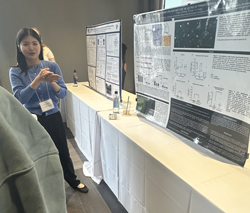Anatomy and Neurochemistry of Major Psychiatric Illnesses
A longstanding focus of our laboratory is examining how pathways through the amygdala are positioned to mediate symptomatology of severe mental illnesses. Over the last decade, multiple human neuroimaging studies show that amygdala dysfunction—its structure, function, or both—is a component of many psychiatric syndromes. Broadly speaking, this is not surprising since the amygdala has long been known to code the salience of external experience. However, the amygdala participates in many diverse and specific functions including fear conditioning and extinction, safety signaling, recognition of emotion in facial expression, and affective responses to primary rewards and punishments. Many of these functions have seemingly opposing goals, raising the question of whether discrete or similar amygdala subregions or cell groups participate in recognizing safety versus reward, or fear learning and extinction. Moreover, the amygdala is a highly heterogeneous structure whose various nuclei have significant differences in structure and connectivity among animal species. Ongoing studies in our laboratory use nonhuman primate models to identify how input/output pathway through the amygdala converge and segregate in order to understand how various types of emotional coding might take place in the human. Because many psychiatric symptoms are brought about by stressful life experiences, we work n collaboration with other nonhuman primate groups, to examine the molecular and cellular features of specific amygdala circuits and subcircuits that are especially important in stress responses. Our work is important in helping to design and interpret outcomes of human neuroimaging work, and we also work with several groups studying manifestations of psychiatric disease in humans.
A new area of study in our laboratory involves models of stress in adolescent rats. Since circuit formation in the amygdala is ongoing during childhood and adolescence, we have several studies investigating the roles of stress on typical amygdala development, and correlated behavioral outcomes.
We invite you to visit our research projects page to see specific projects ongoing in the laboratory.
A word to undergraduates…
We are getting back to our pre-COVID routines, including undergraduate rotations! See details.
Highlighted News from the Lab
Dennisha King wins admission to the 2025 Scholar Mentoring & Development Program for Biotechnology (SMDP Biotech)
 This competitive award supports a year-long mentoring program with industry scientists, in which Scholars develop a Personalized Mentoring Plan and explore roles in the Biotechnology Industry.
This competitive award supports a year-long mentoring program with industry scientists, in which Scholars develop a Personalized Mentoring Plan and explore roles in the Biotechnology Industry.
This program is supported by the International Center for Professional Development, launched and working globally through the UNESCO framework.
Dennisha kicks off this exciting year at the 2025 BIO International Convention, Boston, MA next month.
Congratulations!
 UR Expo 2025 features 125 undergraduate scientists: Phoebe Shin
UR Expo 2025 features 125 undergraduate scientists: Phoebe Shin
Phoebe Shin, a neuroscience major, presents new work that tries to unravel when and how new neurons in the amygdala are lost after early life stress. She presented new findings showing increased apoptosis in developing neurons, potentially explaining neuronal loss in young animals following an early life stressors. Come see a reprise of her work at the Department of Neuroscience Annual Retreat, April 25, Memorial Art Gallery.

Julie Fudge, M.D.
Principal Investigator
- Circuit-Based Approaches to Understanding the Anterior Cingulate Cortex (ACC).; The Journal of neuroscience : the official journal of the Society for Neuroscience; Vol 45(46). 2025 Nov 12.
- Translating stress systems: corticotropin releasing factor, its receptors, and the dopamine system in nonhuman primate models.; Genomic psychiatry : advancing science from genes to society; Vol 1(3), pp. 28-43. 2025 May 13.
- Microglia morphology in the developing primate amygdala and effects of early life stress.; eNeuro. 2025 Jan 03.
- Translational Insights From Cell Type Variation Across Amygdala Subnuclei in Rhesus Monkeys and Humans.; The American journal of psychiatry. 2024 Oct 30.
News
Affiliations
November 17, 2023
Daulton Myers presents on PFC networks to anterior cingulate hubs
November 17, 2023
Dennisha King undercovers microglia changes in the PL amygdala after infant stress
June 22, 2023
Welcome Chisom Ibe from CUNY
Contact Us
Fudge Lab,
601 Elmwood Ave,
Rochester, NY 14642






